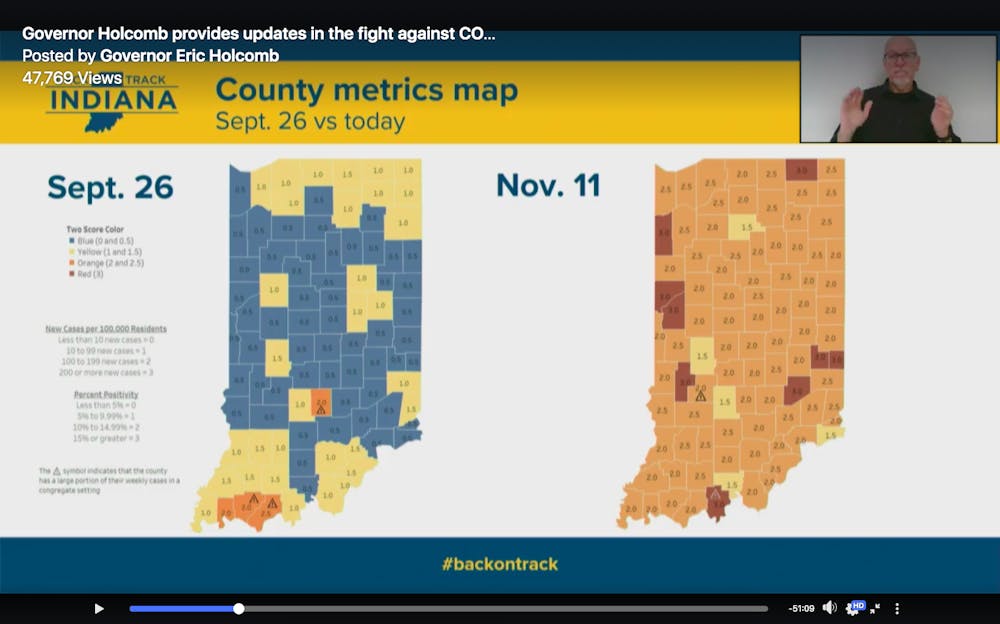Gov. Eric Holcomb said he is eliminating his Back on Track Indiana COVID-19 plan and will sign an executive order to increase statewide COVID-19 restrictions for Hoosiers from Nov. 15 to the end of the month.
Instead of adhering to the guidelines set by Stage 5 in the plan, the state will require counties to follow specific guidelines if they have moderate to high community spread as indicated by Indiana’s county metrics map, Holcomb said at his Wednesday COVID-19 press conference.
The color-coded county metrics map uses a county’s new COVID-19 cases per 100,000 residents and its positivity rate to determine a color for the county on the map. The colors are blue, yellow, orange and red, with blue being the least restrictive regarding recommendations.
This week, there were five yellow counties, nine red counties and the rest were orange. Monroe County is one of the five yellow counties.
“In September, a large majority of counties were blue in the state of Indiana, with low case counts and spread of the virus,” Holcomb said. “This week, no county is blue.”
The counties identified as orange, which is moderate to high community spread, and red, which indicates high community spread, will be required to follow guidelines set by the state.
Some of the requirements for orange counties include restricting social gatherings to 50 people or less, keeping attendance for K-12 extracurricular events to 25% capacity and limiting attendance at community rec sports to participants, required personnel and parents or guardians, said Indiana state health commissioner Dr. Kristina Box.
The requirements for red counties include limiting social gatherings and commercial events to 25 people and only allowing participants, required personnel and parents or guardians to attend indoor K-12 extracurricular and IHSAA activities. Red counties are also recommended to limit hours of operation for bars, clubs and restaurants.
Churches are exempt from this rule, Holcomb said. However, he encouraged churches to consider doing virtual services or putting a COVID-19 plan into place.
“They’re still exempted. However, don’t get me started,” Holcomb said. “We do want to stress that this virus connects with people wherever they are when you let your guard down.”
This week the seven-day positivity rate was 10.3%, which is 6.4% higher than when Indiana moved to Stage 5 on Sept. 26, Holcomb said. As of Tuesday, 2,544 Hoosiers are hospitalized for COVID-19 and about 210 Indiana residents are hospitalized for COVID-19 every day, Holcomb said.
Some hospital officials said their patient numbers may double over the next several weeks, Holcomb said.
Box said Indiana has doubled its COVID-19 cases every week for the last four weeks. Indiana has been at Stage 5 for more than six weeks. It’s important to act now because even if the state begins working to decrease cases today, there are still going to be a large number of individuals being hospitalized for 10 days to two weeks from now, she said.
“This is why we have to turn the tide now,” Box said. “Things will shut down and decrease if we don’t take proactive action now.”
Dr. Lindsay Weaver, chief medical officer for Indiana’s department of health, said last night she worked a shift at an emergency department and treated more COVID-19 patients than she has all year.
“The strain on our hospitals is real,” Weaver said. “Health care workers need you to do your part to help them do theirs.”
Holcomb said one of the reasons he wanted to transition from Stage 5 was because many Hoosiers believed Stage 5 meant the virus was over when the state still wanted people to follow Centers for Disease Control and Prevention COVID-19 guidelines.
“The Stage 5 was being lost on people,” Holcomb said. “Stage 5, to many, was translated to, or received as, ‘we’re past it.’”
Holcomb said his decision to remove Stage 5 was not a political decision, because some have wondered why he waited until after the gubernatorial election to set stricter guidelines.
Indiana will also make $20 million available to local governments to finance things such as COVID-19 public awareness and education, Holcomb said.
Weaver said the state department of health is preparing to receive the first doses of the COVID-19 vaccine in Indiana. She said the first vaccine they expect to receive is being made by Pfizer, a pharmaceutical company that said they may submit for an emergency use authorization as early as the third week of November.
The Pfizer vaccine and the vaccine made by Moderna, a biotechnology company, could come to Indiana by the end of the year, Weaver said. However, the state will not start vaccinating people until they receive the Emergency Use Authorization and the Advisory Committee on Immunization Practices review for both vaccines.



